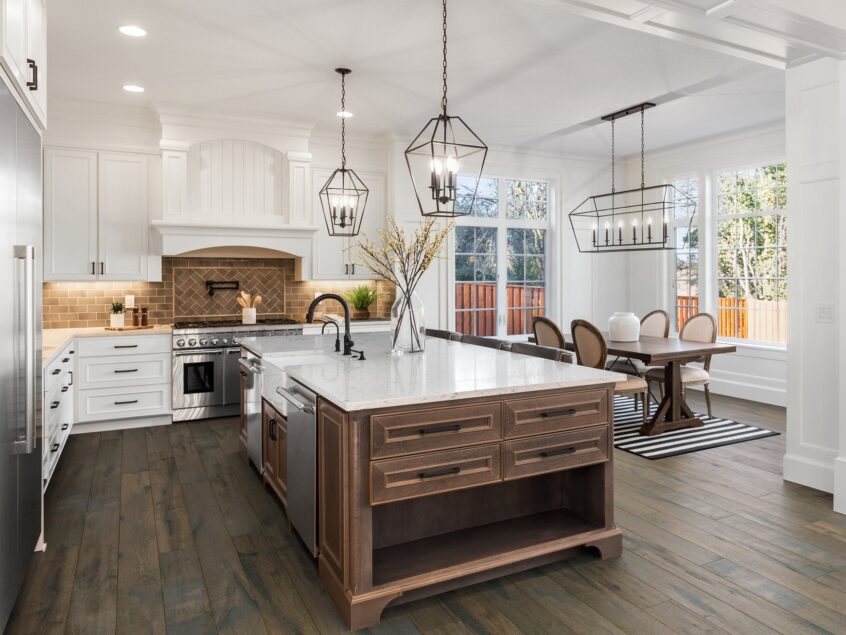Quality vs. Others
Which hardwood is best for flooring?
It’s more of a design and preference decision than a construction, but it’s wise to account for humidity. In Alberta it is very dry, so we recommend engineered White Oak because it is the most stable. Red Oak and properly dried Maple are also good choices.
Is engineered hardwood a good floor?
It’s an excellent floor because it is almost 100% more stable than a solid wood floor. If you have humidity fluctuations, engineered flooring doesn’t expand or contract width-wise like solid wood, so you’re less likely to get gaps between planks.
What are the disadvantages of engineered wood?
In very low humidity, as in below the warrantied range, engineered hardwood floors can crack as the top layer contracts, while the structural layers below do not. However, it is not difficult to replace a few cracked boards here and there; this is why we do recommend customers have an extra box or two of their wood flooring, in case replacements are needed in the future.
Is engineered hardwood just as good as solid hardwood?
Yes, because it is more stable and if the lamella (top layer) is 3 mm or thicker it can be re-sanded just like a solid wood floor. Most ¾” solid wood can be sanded ~4 times. Engineered floors with 3 mm + thick lamellas can be sanded 2-4 times (depending on the thickness of the lamella), and engineered is more stable (no gapping and allowing wider boards) than solid.
Both types of hardwood (solid & engineered) have a tongue and groove, and as long as you don’t reach the tongue when sanding, you can sand and refinish the wood. Some engineered woods have an above-tongue thickness that is as thick as any solid hardwood while being more stable due to the plywood or 3-ply structural layers under the lamella.
Some engineered hardwood uses a thin lamella layer, which will not allow for any sanding or refinishing. If you want an engineered floor that you can re-sand in the future, we recommend 3 mm + thick lamellas.
We have both thinner and thicker lamella options, as being able to sand an engineered hardwood floor is very important to some consumers, but not important at all to others.
Which is better engineered hardwood or laminate?
Engineered hardwood is much better than laminate. Laminate flooring uses a paper top layer, giving it the look of wood, but it cannot be sanded and refinished, and most importantly does not have the look of real wood. Laminate flooring is a low-cost alternative to engineered hardwood and is a single-use floor.
Is luxury vinyl plank better than engineered hardwood?
Some types can be better for surface durability, but they do not add as much value to a home as hardwood. Luxury Vinyl Plank is often sold as “waterproof”. It’s important to remember that while the vinyl flooring itself may not absorb water, your subfloor underneath the vinyl is not waterproof and can absorb water. Vinyl has its benefits in terms of surface durability, but as it is not real wood, it doesn’t have the same look, feel and value perception as an engineered hardwood.
What is the best alternative to engineered wood flooring?
The best alternative is real, solid hardwood. But if you need something that has a harder wearing surface, then Luxury Vinyl Plank is probably your best alternative.
How long does engineered hardwood last?
If the floor has a 3+ mm layer lamella (top layer) of wood that allows for re-sanding/refinishing, it can last 25 – 50 years.
Do engineered wood floors increase home value?
Yes. Engineered hardwood floors increase home value as much as solid wood floors do.
How thick should the top layer of an engineered floor be?
In dry climates like Alberta, Canada, we recommend no more than 3 – 4 mL top layer (lamella). Thicker layers of lamella are suitable for humid regions. A lamella thinner than 2mm cannot be sanded and refinished in the future.
Care
What are common problems with engineered wood?
Having the humidity too low in the winter (below recommended manufacturer’s warranty, usually around 25-60% RH). This can cause the top layer, especially if it is a thick lamella, to shrink and then the boards can crack. The other most common problem is using incorrect cleaners on your wood floor. Cleaners with oils (natural or otherwise) should not be used as the oils can build up on the surface and be very tough to remove.
Is it OK to put hardwood in a kitchen?
Yes, but you must clean spills right away, and avoid getting water directly on the floor as it can swell and stain the wood.
Can you mop engineered wood?
Not with a wet mop. You should always use an approved hardwood floor cleaner like Bona. A misting mop head with the cleaner works well. Never use a steam mop, as it will cause damage that will void any manufacturer’s warranty. When cleaning avoid having moisture left on the boards.
Does engineered hardwood chip easily?
No, not easily. If chips occur it’s often due to a minor crack on the edge that happened during installation that has worked its way into a larger crack as the floor cycles through the higher and lower humidity seasons. Not having felt pads on the bottom of chairs can also cause chips if the chairs are dragged across boards.
Does engineered hardwood need maintenance?
It should be cleaned with a mist-mop and hardwood cleaner. Mostly you’ll be vacuuming and not cleaning. You can spot-clean when needed. Never use a beater-bar attachment on your vacuum cleaner. Also, keep a constant relative humidity. If your home is too dry on your skin, it is likely also not good for your floor.
Do engineered hardwood floors scratch easily?
Not easily, but they can be scratched. However, we do recommend trimming the nails on your pet’s feet, using soft pads on the bottom chairs, and avoiding walking on them with spike-heeled shoes. Also, if you have kids or pets, we recommend getting a low sheen wire-brushed textured finish, as a smooth, glossy finish will show scratches more easily.


